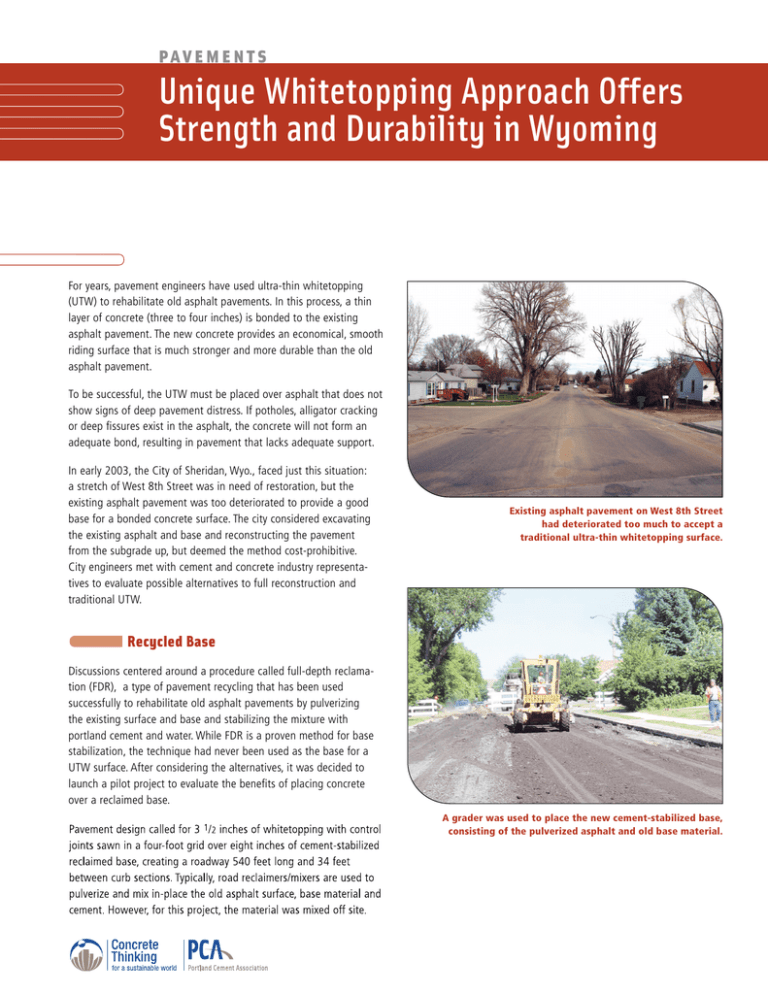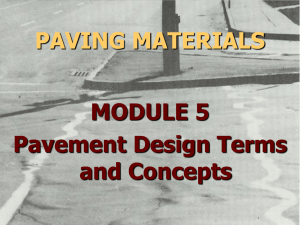
PAVEMENTS
Unique Whitetopping Approach Offers
Strength and Durability in Wyoming
For years, pavement engineers have used ultra-thin whitetopping
(UTW) to rehabilitate old asphalt pavements. In this process, a thin
layer of concrete (three to four inches) is bonded to the existing
asphalt pavement. The new concrete provides an economical, smooth
riding surface that is much stronger and more durable than the old
asphalt pavement.
To be successful, the UTW must be placed over asphalt that does not
show signs of deep pavement distress. If potholes, alligator cracking
or deep fissures exist in the asphalt, the concrete will not form an
adequate bond, resulting in pavement that lacks adequate support.
In early 2003, the City of Sheridan, Wyo., faced just this situation:
a stretch of West 8th Street was in need of restoration, but the
existing asphalt pavement was too deteriorated to provide a good
base for a bonded concrete surface. The city considered excavating
the existing asphalt and base and reconstructing the pavement
from the subgrade up, but deemed the method cost-prohibitive.
City engineers met with cement and concrete industry representatives to evaluate possible alternatives to full reconstruction and
traditional UTW.
Existing asphalt pavement on West 8th Street
had deteriorated too much to accept a
traditional ultra-thin whitetopping surface.
Recycled Base
Discussions centered around a procedure called full-depth reclamation (FDR), a type of pavement recycling that has been used
successfully to rehabilitate old asphalt pavements by pulverizing
the existing surface and base and stabilizing the mixture with
portland cement and water. While FDR is a proven method for base
stabilization, the technique had never been used as the base for a
UTW surface. After considering the alternatives, it was decided to
launch a pilot project to evaluate the benefits of placing concrete
over a reclaimed base.
Pavement design called for four inches of whitetopping with control
joints sawn in a four-foot grid over eight inches of cement-stabilized
reclaimed base, creating a roadway 540 feet long and 34 feet
between curb sections. Typically, road reclaimers/mixers are used to
pulverize and mix in-place the old asphalt surface, base material and
cement. However, for this project, the material was mixed off site.
A grader was used to place the new cement-stabilized base,
consisting of the pulverized asphalt and old base material.
First, crews used a milling machine to pulverize and recover the old
pavement section to a depth of eight inches, placing the reclaimed
material in a stockpile. The original plan called for blending the
reclaimed material with 5% cement in an off-site central plant pug
mill and trucking it to the project site, but scheduling difficulties
made the equipment unavailable. Instead, the material was blended
with cement in transit mixers and placed on the subgrade. The discharged material was initially too wet to compact immediately with a
roller; however, after some additional in-place mixing with a grader,
the cement-stabilized material achieved the proper moisture content
for compaction. Crews then placed whitetopping over the base using
a deck-finishing unit.
Pavement Performs
Tests performed after construction showed the cement-stabilized
base had a compressive strength of about 320 psi in 28 days; the
concrete achieved a compressive strength of 5,250 psi in 28 days.
The most important aspect of the pilot project—the bond between
the whitetopping and the stabilized base—was evaluated with core
samples taken shortly after construction. The cores showed excellent
bonding between the surface and base layers.
Crews place ultra-thin whitetopping
over the cement-stabilized base.
Today, after almost one year of traffic, the section is performing well,
and the City of Sheridan is pleased with the results. City engineers
will continue to monitor the West 8th Street project in coming years.
Those who worked on the pilot project say the process shows
promise for use in other projects where old, deteriorated asphalt
pavement can be reclaimed and surfaced with UTW.
Full-Depth Reclamation with Cement
Deteriorating roads are a constant problem for cities and counties.
That’s why engineers and public works officials are turning to a
process called full-depth reclamation (FDR) with cement.
The new concrete roadway provides an economical, smooth,
light surface, with excellent strength, durability, and appearance.
This process rebuilds worn-out asphalt pavements by recycling the
existing roadway. The old asphalt and base materials are pulverized,
mixed with cement and water, and compacted to produce a strong,
durable base for the new pavement surface.
For more information on ultra-thin whitetopping, visit the Web site of
the American Concrete Pavement Association (www.pavement.com).
Full-depth reclamation recycles the old asphalt and base material
for the new road. There’s no need to use new aggregate or dispose
of old material.
For local support, tap into the cement industry's network of regional
groups covering the United States. Contact information is available at
www.cement.org/local.
More Information
PCA offers a broad range of resources on soil-cement and rollercompacted concrete applications for pavements. Visit our Web site
at www.cement.org/pavements for design and construction guidelines, technical support, and research on cement-modified soils,
soil-cement base, cement-treated base, and full-depth reclamation.
© 2004 Portland Cement Association
All rights reserved
An organization of cement companies to
improve and extend the uses of portland
cement and concrete through market
development, engineering, research,
education, and public affairs work.
PL612



